TOUMANI DIABATE & ROSWELL RUDD / “Jackie-ing”
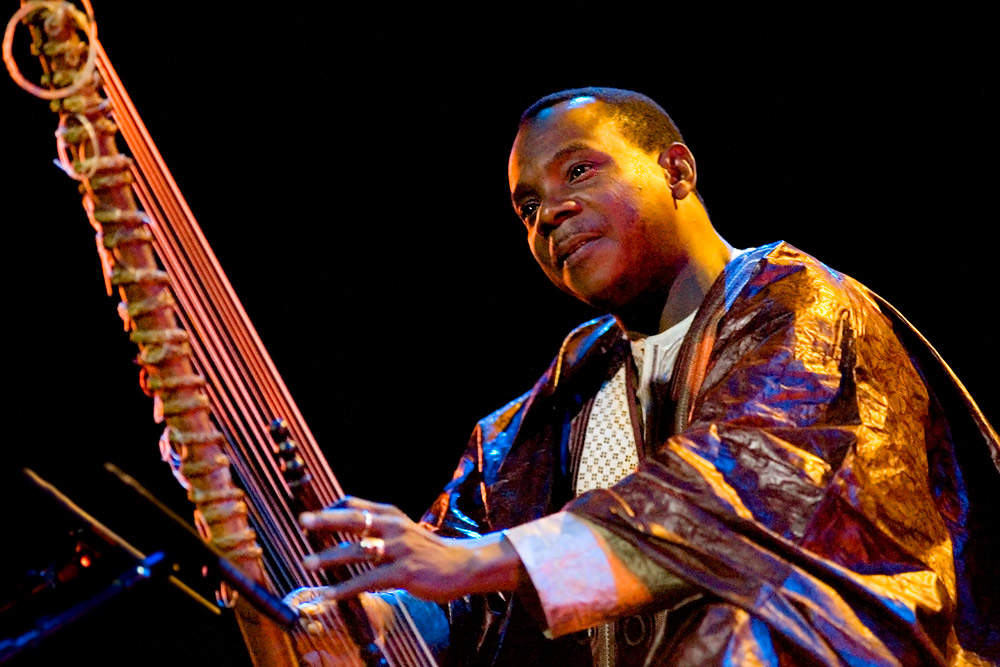
And in the third week Kalamu gave them Toumani Diabate playing blues and jazz, and they were mighty well pleased. They had not heard blues like this before and who would have thought jazz trombone and West Africa kora could so felicitously entwine. But hearing is believing and now they all believed. Let the congregation say “ashe.”
So yes, I am a Toumani cheerleader. Give me a “T”…
With respect to both the blues and the jazz albums, Toumani is bringing his own band to the game. It’s not just him soloing, he’s directing the whole joint, rolling the ensemble and the soloists together, elevating the resulting mash-up. While it is often difficult enough to solo within a context that is not your regular way to roll, but imagine what it must be like to take your homeys and run up on somebody else’s court and play the hell out of their game even though you never played their game before at the professional level.
Toumani and the folk from Mali take it all in stride. They name it and claim it. I particularly dig Lassana Diabate's ballaphone workouts. When the music ends, regardless of who remains in your ear, the major truth is that Toumani Diabate was the glue holding the two projects together. He was the one everyone else coud understand even when some of the musicians couldn't understand each other. Toumani Diabate is not only a monster kora player, he is also and more importantly, an intelligent and sensitive musical director. Toumani understands music, of whatever style or genre, and knows how to guide deseparate musicians to work as a cohesive whole.
Early American blues. Recordings by Lightnin' Hopkins, Skip James, and John Lee Hooker are amazing because two-thirds of what they're playing is in the African mold, and one-third articulates the American experience. The density of African music without blues notes is incredible, because it wasn't disconnected by slavery. The blues scale isn't missing, but the notes haven't been crunched down to express the sharp pain of being treated like animals for generations. Africans are always transfixed when they hear what Africans in America have done with the music. The blues is something special that happened here in this country.
—Taj Mahal
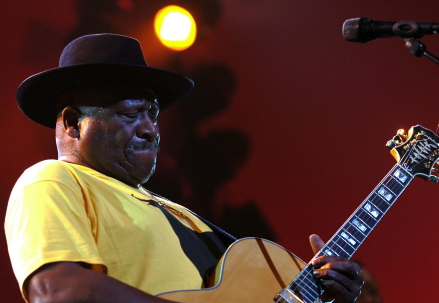
I’m always in Africa in my head. I think that it goes back to DNA. Everybody’s DNA goes back to Africa.The blues album is Kulanjan and is a collaboration with world bluesman Taj Mahal. Just Taj’s name tells you something about his weltanschauung; my man sees the whole world as his back yard to play in and his walking road to roam upon. And no matter where he goes, the song always sounds like the blues even when it don’t quite be the blues he be playing, or even when Taj is working with some cats who the closest they been to Mississippi is when George bush visited their country in Africa.
—Taj Mahal
Taj understands that there is a significant difference but he also knows that beneath the different fruit growing on the American tree is the African root, which is a human root, and therefore means that there are connections deeper than skin.
Plus, Taj, he carry some magic dust up in his gris gris pouch that allow him to eat the local food but still produce his own shit. (The reason I’m playing with all these mashed-up metaphors that obliquely directly address the subject at hand is to kind of give you a flavor of what the resulting music sounds like.) That magic dust is his love of music, which is the art that via the ears goes directly to the heart.
Anyhoo, scholars been trying to trace the blues back to Africa for a long time now and they usually end up somewhere in Mali, lost as a mofo, i.e. a Republican on November 4th, 2008!
You can catch traces of the music peek-a booing with you in the griot songs but it don’t quite be fully the blues, sort of like a kissing cousin or something close enough to be almost related and yet distant enough that you can have intimate interactions and you wouldn’t be arrested for incest.
Check out how bluesy it sounds long as Taj is singing but soon as sister lady swoops in, poof!, the blues is replaced with a more ancient feeling that just kind of stirs up sentiments inside you that you ain’t knowed you had ever felt, but you had, just that when you felt it was a couple of centuries ago—you know the mind is feeble compared to the feeling the dna can carry.
You might not “know” something but you can “feel” it. Which would you rather to know something or to feel something? Personally, I prefer both but if I had to choose, I’d go with experience over theory any day of the week. From the experience I can develop my own theories but theory alone will never give me experience. I don’t start in the abstract in my mind but rather in the concrete somewhere in the world.
Anyway, I kept going back and forth on which cut to feature. It would have been simple to do another mixtape but, hey, for the past two weeks I’ve dropped Toumani mixtapes. So I decided buckle down and pick a number, leave ‘em wanting more. But it’s hard, you know, because the albums are so different. My first inclination was toward the jazz album but then I listened a minute to the blues and said, oh, yeah, we gotta… But then again when I heard Toumani and ‘em tackle Monk’s “Jackie-ing” what else could I do but surrender.
The jazz pieces are incredible in their complexity, not just the rolling rhythms but also how they float the harmonies and interweave the melodies. The balafon (the wooden xylophone-like instrument) has fixed notes and the kora also but the way Toumani’s gang plays those instruments you would swear the notes are bending and blending.
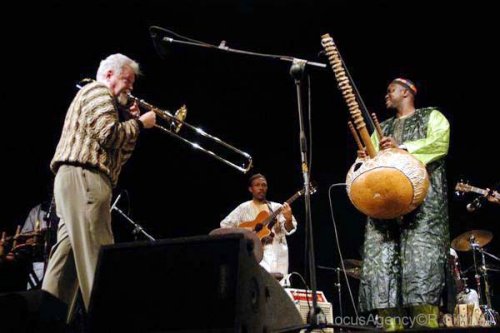
Jazz trombonist Roswell Rudd noted that the African impulse was to ride the rhythm and improvise on a given beat for as long as they felt like doing it. The musicians did not have to change at a given point, whereas in the western song structure, there are definite points in the music where you are supposed to use different chords.
Think of the differences between bebop jazz and modal jazz. Think of how Bird and Dizzy used all these chord changes, whereas Miles (who never was too swift as a bebop trumpeter) took the music in another direction. In fact, if you want to go all the way deep, then understand that rap is an African song form—ride the beat as long as you want, don't have to have chord changes.
Within the black music tradition, i.e. the tradition of the musics that were created in the diaspora, there is always this tension between riding the rhythm with one chord, two at the most, and playing chord changes a la the west. Again, I think it’s hip to be able to do both and to know what you’re doing either which way you blow.
Check out what the crew does with Monk’s tune, “Jackie-ing.” It must have been a beast for Toumani and cohorts to learn to play that one, not because of the notes but because of following the song structure and improvising in a way completely different from what they were used to using. And then there's "Mali Jam," which is an adaptation of Beethoven's "Ode to Joy" with quotes from other sources including "Get Happy." To hear Malian musicians on traditional instruments working with a jazz trombonist play Beethoven—talk about mellifluous cognitive dissonance! Malicool is an extraordinary jazz album. BTW, “Sena et Mariam” is a George Gershwin composition and "All Through The Night" is a traditional Welsh song adapted by Roswell Rudd.
Undoubtedly the blues of Kulanjan will be easier for most listeners to hear and understand. Indeed, many people will immediately recognize the blues numbers, especially “Catfish Blues” and “Queen Bee.” I doubt if there is an American band that could have gone to Mali and recorded traditional Malian music with only three or four days to learn it, which is what happened with Kulanjan. The album was recorded in a house in Athens, Georgia in which for about four days the musicians lived, rehearsed and settled into the music.
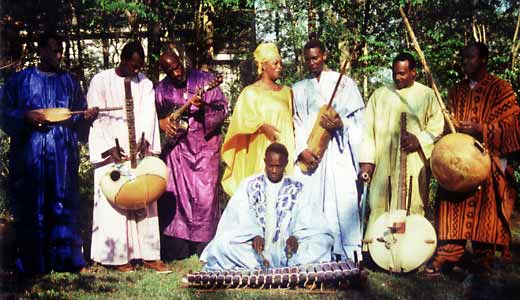
Photos courtesy and copyright © Banning Eyre all rights reserved
The Kulanjan Ensemble
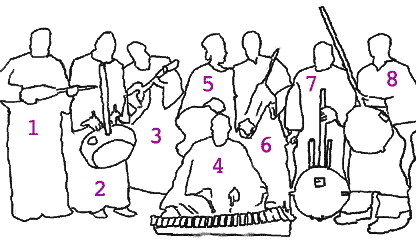
1. Bassekou Kouyate
2. Ballake Kouyate
3. Taj Mahal (a.k.a. Dadi Kouyate)
4. Kassemady Diabate
5. Ramatou Diakite
6. Lasana Diabate
7. Toumani Diabate
8. Dougouye Koulibaly
The Malicool session worked the other way around. Roswell Rudd went to Africa and hung with Toumani for a minute. In fact, there’s a hip, hip documentary about the encounter called Bamako Is A Miracle. It is a sometimes brutally honest documentary about the process of putting the music together, which also includes the business matters (payment, recording schedules, travel, etc.) surrounding the making of the music. You might want to check it out.
The Malicool band is Roswell Rudd (trombone), Toumani Diabate (kora), Lassana Diabate (balafon), Basseko Kouyate (ngoni), Henry Schoy (bass), Sayon Sissoko (guitar), Sekou Diabate (djembe), Mamadou Koutate (vocals on "Rosmani" and "Hank"), Dala Diabate (vocals on "Hank"). 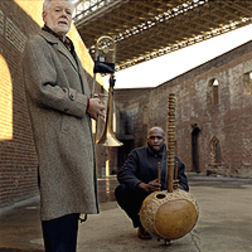
Roswell Rudd is one of the most adventurous trombone players on the planet. He made his major mark in jazz playing avant garde, was a long time member of the Archie Shepp ensemble. Also recorded a classic jazz album The New York Art Quartet (1964) that included Amiri Baraka as a guest reciting his poem Black Dada Nihilissimus. Beyond the avant garde, Rudd has worked with both traditional jazz players and recorded with musicians all around the world.
But anyway, either you dig this latest installment of music from Toumani or you don’t. If you dig it there is more to learn, if you don’t, just chalk up the sounds as an experience you’re not feeing but nevertheless an experience that is musically significant.
Enough.
(Hopefully) Enjoy.
—Kalamu ya Salaam
This entry was posted on Monday, March 9th, 2009 at 1:07 am and is filed under Contemporary. You can follow any responses to this entry through the RSS 2.0 feed. You can leave a response, or trackback from your own site.
One Response to “TOUMANI DIABATE & ROSWELL RUDD / “Jackie-ing””
March 12th, 2009 at 7:20 pm
Sorry to have missed your recent coverage of Diabate. *Very* sorry, truly. This Monk cover trips me up with the intersections of textures and histories. I’m gonna have to listen a few more times at least. Thank you!
Leave a Reply
| top |